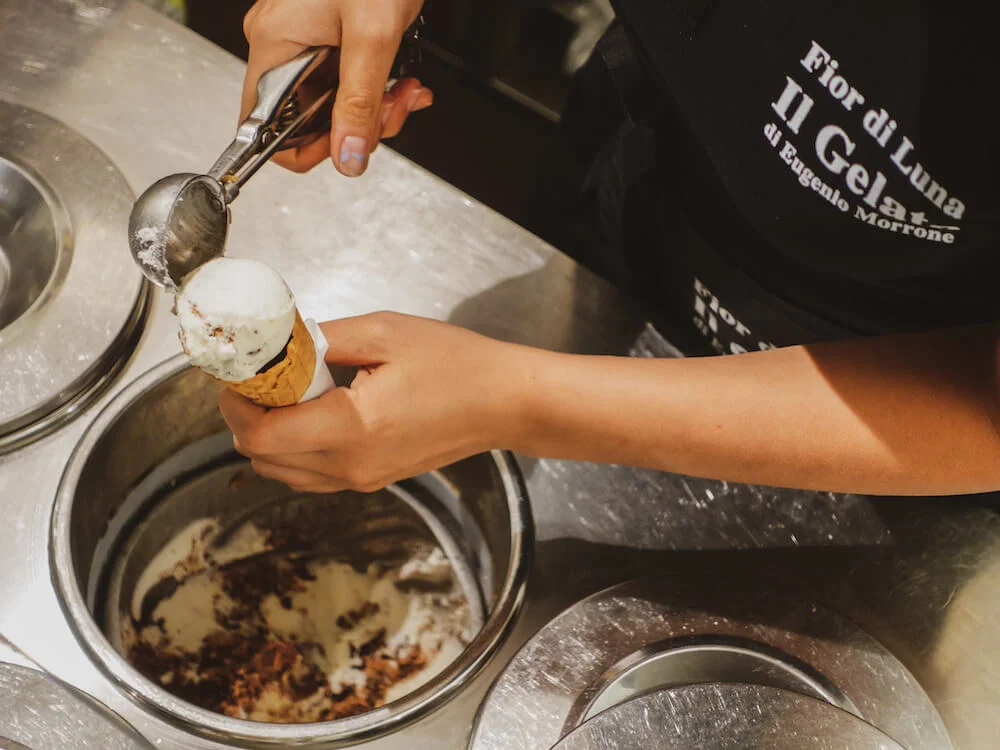Anyone who’s ever tried gelato in Italy will have been blown away by how different it tastes from the ice cream back home. At face value, Italy’s frozen delight might seem like ice cream served in a fancy scoop. But scoop below the surface and there’s a whole world of differences.
This post dives right into the gelato vs ice cream debate: exploring what is gelato, how it’s made, and the difference between gelato and ice cream in terms of texture and flavour. We’ll even break down how many calories are in gelato vs ice cream—just because we’re nice like that.
So without further ado, let’s see what sets Italian gelato apart from its creamier cousin.
What is the Main Difference Between Gelato and Ice Cream?
The main difference concerns their ingredients and preparation. Both are frozen dairy desserts and so, broadly speaking, types of ice cream. But gelato is made and served in a way that gives it distinct qualities.
The Takeaway
- Dairy content: The base of ice cream is heavy cream (often with egg yolks), but gelato is made with a greater proportion of milk. Gelato also typically does not contain eggs.
- Fat: Gelato has a much lower fat content (around 4–9%) compared to ice cream (usually 10–25% fat). Less fat gives gelato a lighter, more discernible taste.
- Air: Ice cream is churned quickly, whipping in a lot of air (up to about 50% of its volume). Gelato, by contrast, is churned slowly with minimal air (only about 20–30%), making a denser and more rippled finished product.
- Serving temperature: Gelato is stored and served warmer (around 15°F or -9°C) than ice cream (0°F or -18°C). Not being frozen solid is what gives gelato a softer, silkier consistency. On the flip side, you have less time to eat it under the sweltering Italian sun!
- Texture and flavour: Gelato’s lower fat and warmer serving temp yield a silkier texture and more intense flavour, whereas ice cream is a bit creamier and more buttery, and its flavours can be more muted.
Breaking Down the Big Differences
Gelato and Ice Cream Use Different Dairy
The biggest difference is in the dairy base (and the use of eggs). Ice cream is typically made from a custard base that includes heavy cream and often egg yolks. This high-fat mixture gives ice cream its rich taste and velvety thickness. Many traditional ice cream recipes use egg yolks to create a thick custard before churning, resulting in that creamy scoop we know and love.
Gelato, by contrast, uses more milk than cream. An authentic gelato base is milk-forward – usually whole milk – with little or no added cream. Importantly, gelato usually does not include egg yolks at all. Italian gelato makers traditionally avoid eggs, letting the dairy and flavourings speak for themselves. The result is a dairy dessert that has less fat and a purer taste of its main ingredients.
(Yes, gelato does have dairy—it’s milk-based, just made with more milk than cream).
With gelato’s milk-based recipe, you get a lighter base that brings out the best in more subtle flavours. Ice cream’s cream-and-egg base gives it a heavier, richer mouthfeel—that classic creamy richness—which can slightly mellow the intensity of added flavours.
Gelato Is Stored at Lower Temperatures
Ice cream is typically stored very cold—around 0°F (about -18°C)—meaning it stays quite firm. Gelato, on the other hand, is stored and served at a warmer temperature, roughly 15°F (around -9°C). That’s still frozen solid of course, but it’s still much cooler than ice cream.
So why does temperature matter? Well, because gelato doesn’t numb your tongue’s taste buds as much, you can perceive its flavours sooner and more acutely.

Gelato Contains Far Less Fat
Another major difference is the butterfat content. Ice cream is a high-fat treat. In fact, by U.S. law it must contain at least 10% milk fat, and many premium ice creams range from 14% up to 20% or more. Gelato, using more milk and little to no cream, has significantly less fat—usually only about 4% to 9% fat.
All that butterfat contributes to a creamy taste and smooth texture, but it also coats the tongue and mutes the ice cream’s flavours. Since gelato is lower in fat, its flavours tend to hit your palate—and send good food vibes to your brain—more directly.
Nutritionally speaking, gelato’s lower fat content can make it a lighter choice in terms of calories. For example, about a half-cup of vanilla gelato has roughly 160 calories, whereas the same amount of vanilla ice cream packs around 210 calories.
Ice Cream Contains More Air
Gelato tends to feel more dense and creamy than ice cream, which often seems lighter or fluffier. During the churning process, air is incorporated into the mixture (called “overrun”). Ice cream is typically churned fast and vigorously, whipping in plenty of air. In many commercial ice creams, air might make up between 20% to 45% of the volume by the time it’s frozen. All that air gives ice cream a softer, airy texture, and it’s perfectly safe.
Consequently, even a small cup of gelato can feel quite filling, since you’re getting a lot of pure frozen goodness rather than our cheapest food additive: air. By contrast, ice cream’s extra air gives it a light, cloud-like quality and causes it to melt more quickly on the tongue. If you’ve ever thought gelato seems heavier or more satisfying than ice cream, that’s because it does have more of the actual product and significantly less air.

The Main Difference Is the Flavour (and Texture)
All the factors above—fat content, air, and serving temperature—come together in the flavour and texture experience of gelato vs ice cream. Gelato often tastes more intense and feels smoother, while ice cream’s flavour is a bit more mellow and its texture is lighter.
Because gelato has less fat and is served slightly warmer, the flavour comes through more quickly and sharply. Your taste buds aren’t numbed by extreme cold or coated in fat, so you get the full impact of the taste right away.
Texture-wise, gelato is silky and dense. It’s smooth and slightly chewy due to the low air content. Ice cream is also creamy, but it’s usually a bit firmer when frozen. Gelato just feels softer and more luxurious on the tongue, whereas ice cream feels colder and more solid.


So Is Gelato Better than Ice Cream?
Ultimately it depends on what you value in your creamy frozen treats. From a health standpoint, gelato is on balance slightly healthier since it has lower fat and calories. If you want an indulgence with a lighter nutritional load, gelato edges out ice cream. But remember, both gelato and ice cream have lots of sugar and should be occasional treats (unless you’re on holiday in Italy, in which case Carpe Diem and go wild).
From a taste standpoint, it’s a purely personal preference. Gelato is dense, silky, and intense in flavour and will be preferable for people who love bold flavours and a smooth velvety texture. Ice cream tends to be more creamy, fluffy, and comforting and, unless you grew up in Italy, probably tastes more like home.
A Short Scoop History of Gelato
Variations of gelato have been around for centuries. According to legend, the precursor to modern gelato was invented in 16th-century Florence by the chef, architect, theatrical designer, artist, architect, military engineer, and all-around handy guy to have around Bernardo Buontalenti.
Bernardo had a passion for ice conservation and cooking, and invented his Medici patrons a frozen dessert that combined cream, milk, eggs and the new spice on the block—sugar.
❓Did you know that you can still find the “Buontalenti” gelato flavour in Florence? Try it at Gelateria Badiani and check out this extra-tasty Florence Food Tour 👀
For Italians, the word gelato just means “ice cream”. But the word gelato actually comes from the Italian verb gelare, meaning “to freeze”.
Join a Cooking Class in Rome to Recreate Real Italian Recipes
If learning about gelato has sparked your appetite for Italian cuisine, why not take that enthusiasm into the kitchen? Rome with Chef offers immersive small-group and private cooking classes in Rome where you can learn to create authentic Italian recipes yourself.
Our hands-on Pasta & Tiramisù Making Class lets you craft fresh pasta from scratch and whip up a classic tiramisù. Or join the fun at our Spritz & Spaghetti Class, where you’ll cook a traditional Roman pasta dish and mix Italy’s iconic Spritz cocktail to go with it.
Prefer to immerse yourself in Italian food by tasting rather than cooking?
Join our Rome Trastevere Food Tour! As you explore the medieval district of Trastevere, you’ll sample Roman specialities like supplì (crispy fried rice balls), pizza al taglio, and the main Roman pasta types, and finish off with some of the best gelato in town.
See you soon in Rome! And in the meantime, buon appetito 😩🤌







